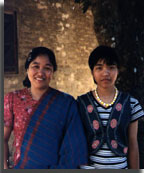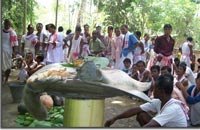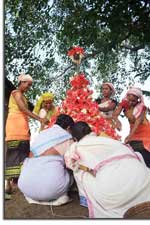History
The Lalung Tribe resides in the states of Assam and Meghalaya, northeastern India. These tribes are divided into two main sub-divisions: those who live in the hills and those who live on the plains. The difference is due to terrain and ecology. The Lalung Tribe belongs to a race known as the Bodo. Many legends are surrounding the history of the Lalung, making their origin rather uncertain.

Origin
These tribes have a mythological and historical origin and migration. Lalung belong to Karbi word it literally can be divided into two words where "Lang" means water and "Lung" means to sink in it. The words compounded together became Lalung. According to some legend the Lalungs fell into river Kolong in Nagaon district while they were trying to cross the river during the invasion of Assam by the Myanmarese. The Karbis rescued them and from then the Karbis called them Lang-lung which the time passed became Lalung. According to another legend the Lalungs left their original homeland to settle on the banks of river Nailalung, a tributory of Daiyang River, which is in the Karbi Anglong district during the reign of the Kamata kings. And therefore the Lalungs derived their name from the river Nailalung. There are beliefs that king Bali a devotee of lord Vishnu was the original ruler of the Lalungs. Once he proclaimed that all his subjects should follow the same religion.
Place /Location (then and now) |
Assam and Meghalaya |
Population |
19,100 |
Languages spoken |
Bodo, Lalung |
Religion/God |
Hinduism & Buddhism /Keshai Khaity |
Food |
Rice, meat, fish and eggs |
Culture

The clans cooperate with one another as a community, whether constructing a house, harvesting rice, or worshipping. Every clan has its own place of community worship where there is an titlear for the clan's god. "Khel" is traditional village council of the Lalung tribals. The village herdman presides over the sitting of the "Khel". The Khel selects the "Giyati"(Priest) to preside over the religious occasions. The "Barilk" (Laiason official between the village headman and the villagers) and the "Zolo" (The expert of Folklore) are also selected by the Khel. The decision of the village headman is final in all matter but in the religious matter only the Giyati can make the final decision.
Occupation
The Lalung tribe in India who live in the hilly areas practice the "slash and burn" method of farming. The tribes living on the plains have been influenced by wet rice cultivation methods, and rice has become their major crop. Sesame, mustard, ginger, and chilies are also grown by this tribe. The Lalung economy suffers from the same drawbacks as other local tribes, such as land alienation, indebtedness, lack of modern techniques, and inadequate credit and marketing facilities.
Food
Rice is the staple food of the Lalung Tribe along with meat, fish, or eggs. Fowl and pork are considered delicacies. These tribes enjoy drinking locally brewed rice-beer on a daily basis. The consumption of rice-beer is disappearing among the plains Lalung due to economic problems. Nevertheless, it is still an essential part of certain religious ceremonies. Today, the more educated Lalung encourage drinking tea rather than beer.
Languages
Many of the hills dwellers are bilingual, speaking both Bodo and Lalung, while many of the plains dwellers speak only Bodo.
Festivals

More than 200 birds are sacrificed, which used to be collected from each family of the village as a tradition.More than 300 devotees participate in the festival. The Lalung Tribe in India follow the cult of "poly-demonism." Their supreme god is called phi which means "father." They are officially classified as Tantrayana Buddhists, but have been influenced by Hinduism as well. At the present time there are only 66 known Lalung believers in India. There is a need for the scriptures and other Christian literature to be translated into Lalung. Additional laborers are also needed to join the Missions agency that is currently working among this people group.


